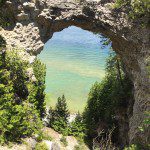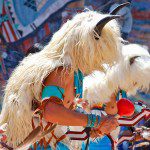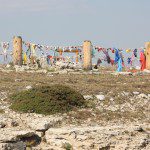Today’s post may seem a little odd, for I’m going to tell you about a holy place that I tried to visit but didn’t.
On a recent trip to visit relatives in South Dakota, my husband and I had planned to make a detour to Wounded Knee, the site of a massacre of Lakota Indians in 1890. It’s located on the Pine Ridge Indian Reservation, which despite being one of the poorest places in the U.S. has its own stark and evocative beauty.
Unfortunately, once in South Dakota we learned that there was significant road construction on the way to Pine Ridge, which would have doubled our travel time to get to the monument. We reluctantly decided we wouldn’t make the trek, and instead visited the Wounded Knee Museum in Wall, a small town on the edge of Badlands National Park. We did so with some trepidation, given Wall’s penchant for exuberant but somewhat tacky visitor attractions (Exhibit A is Wall Drug, a tourist trap of such exuberance and size that one can’t help but marvel at it).
The museum, while small, proved to be a powerful experience. Its exhibits tell the tragic story of the massacre, setting it in its historical context, detailing its villains and heroes, and exploring what happened in its aftermath. During a bitterly cold December a group of about 400 Indians was traveling from Standing Rock Indian Reservation to Pine Ridge. Hungry and dispirited, they were intercepted by members of the U.S. 7th Cavalry Regiment. After escorting them for five miles, the cavalry kept watch as they made camp. On the morning of December 29, the soldiers tried to disarm the men in the group and tensions quickly escalated. A firefight ensued during which at least 146 Lakota died, with many others likely dying later of their wounds. A mass grave was dug at the site with the bodies of 84 men, 44 women, and 18 children.
![Burial_Party_Wounded_Knee[1]](http://wp.production.patheos.com/blogs/holyrover/files/2011/06/Burial_Party_Wounded_Knee1.jpg)
and the occupation of the monument in 1973 by members of the American Indian Movement.
In the center of the museum was a place that felt like a holy shrine. Its focal point was a photo of a massacred Indian sprawled in the snow. Below were tokens left by visitors—flowers, tobacco bundles, money, a cross. A small sign said that the offerings would be taken to the site of the mass grave at Wounded Knee. Hanging from the ceiling was an arrangement of simulated eagle feathers, each representing the death of someone at Wounded Knee, and on either side of the shrine were the names of those buried at the mass grave.
I would guess that the little museum is not without controversy. It’s not affiliated with any Indian tribe and given what I know about the complicated politics between whites and Indians in South Dakota, there are probably some who disapprove of its existence. But I thought it was respectfully done, and I want you to know about it because you might be traveling across South Dakota one day and you should know that Wall has more attractions than just Wall Drug. The little museum, sad as its story is, records an important chapter in American history, one that we shouldn’t gloss over or forget.
But the larger point I want to make is this. In retrospect, I think it’s a good thing that I wasn’t able to visit the actual site of Wounded Knee, because I don’t think I’m ready for it. The museum made me realize how much I don’t know about the story of the massacre. If I would visit the site now, I wouldn’t be able to fully enter into the spirit of the place. To truly appreciate the subtleties and depths of a holy site, one has to be prepared, because much of what is sacred is not visible. Entering into the holy depends upon the preparation you have made and the state of mind you are in. Otherwise, a place like Wounded Knee is just another historical marker on some lonely stretch of highway.
One day I will visit Wounded Knee, and when I do I will try to honor it by knowing its story well. In the meantime, if you’re driving through western South Dakota, stop by the Wounded Knee Museum. It tells a story that we need to hear.











